Ethics Case Study: Analysis of Healthcare Scenarios and Nursing Roles
VerifiedAdded on 2023/04/24
|7
|1343
|419
Case Study
AI Summary
This case study examines three healthcare scenarios, each presenting unique ethical dilemmas. The first scenario focuses on a 32-year-old woman considering abortion and egg freezing, prompting discussions on bioethics, ethical decision-making, and the nurse's role in respecting patient autonomy while addressing potential conflicts with personal values. The second scenario explores issues of patient privacy and professional misconduct when a nurse posts a photo of an unconscious patient on social media and steals from the patient. The third scenario presents a case involving end-of-life care, including withholding nutrition, CPR, and the patient's cultural and religious preferences, and the ethical implications of these decisions. Each case study includes questions and answers related to ethical principles, legal considerations, and the application of nursing standards and guidelines.
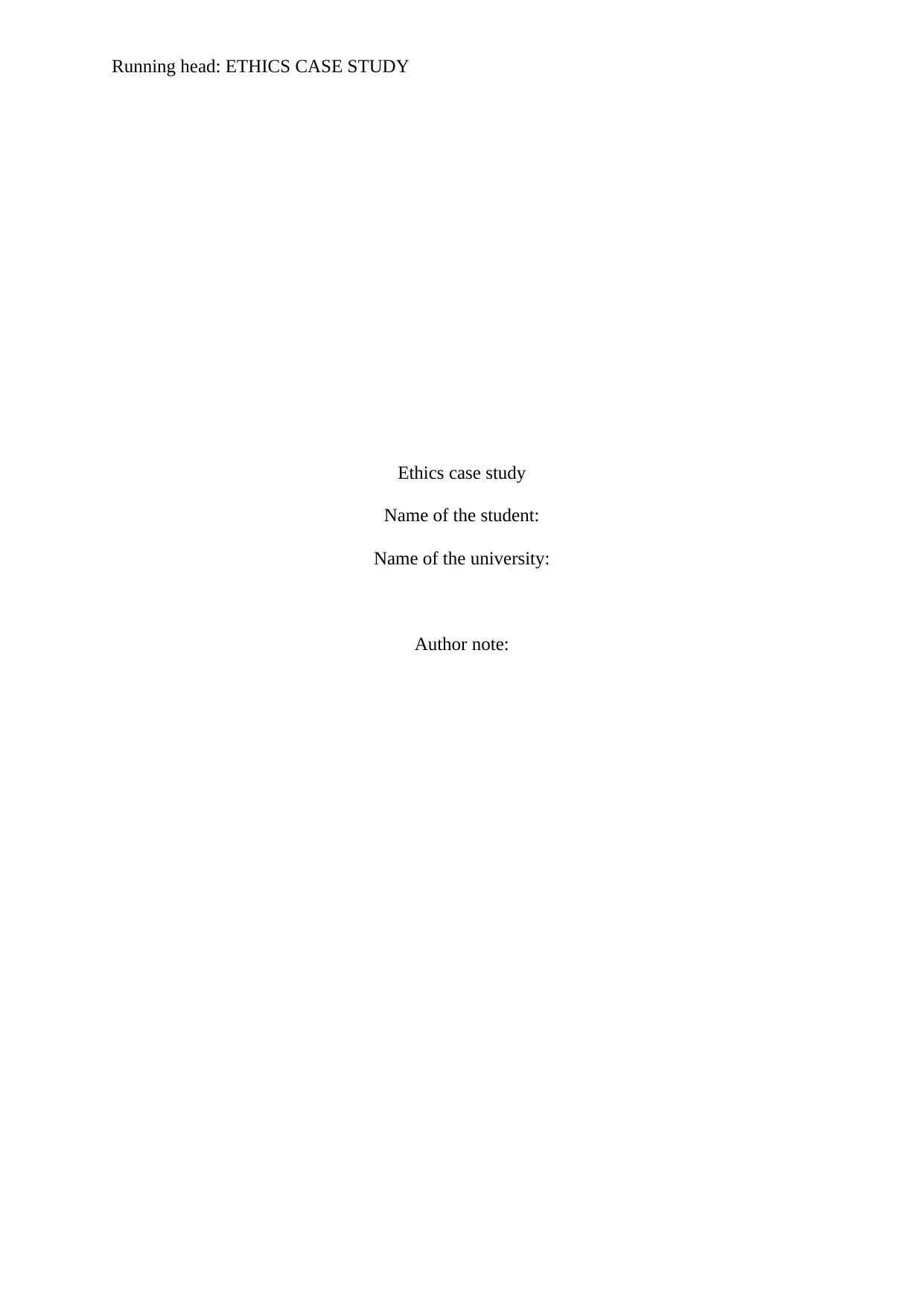
Running head: ETHICS CASE STUDY
Ethics case study
Name of the student:
Name of the university:
Author note:
Ethics case study
Name of the student:
Name of the university:
Author note:
Paraphrase This Document
Need a fresh take? Get an instant paraphrase of this document with our AI Paraphraser
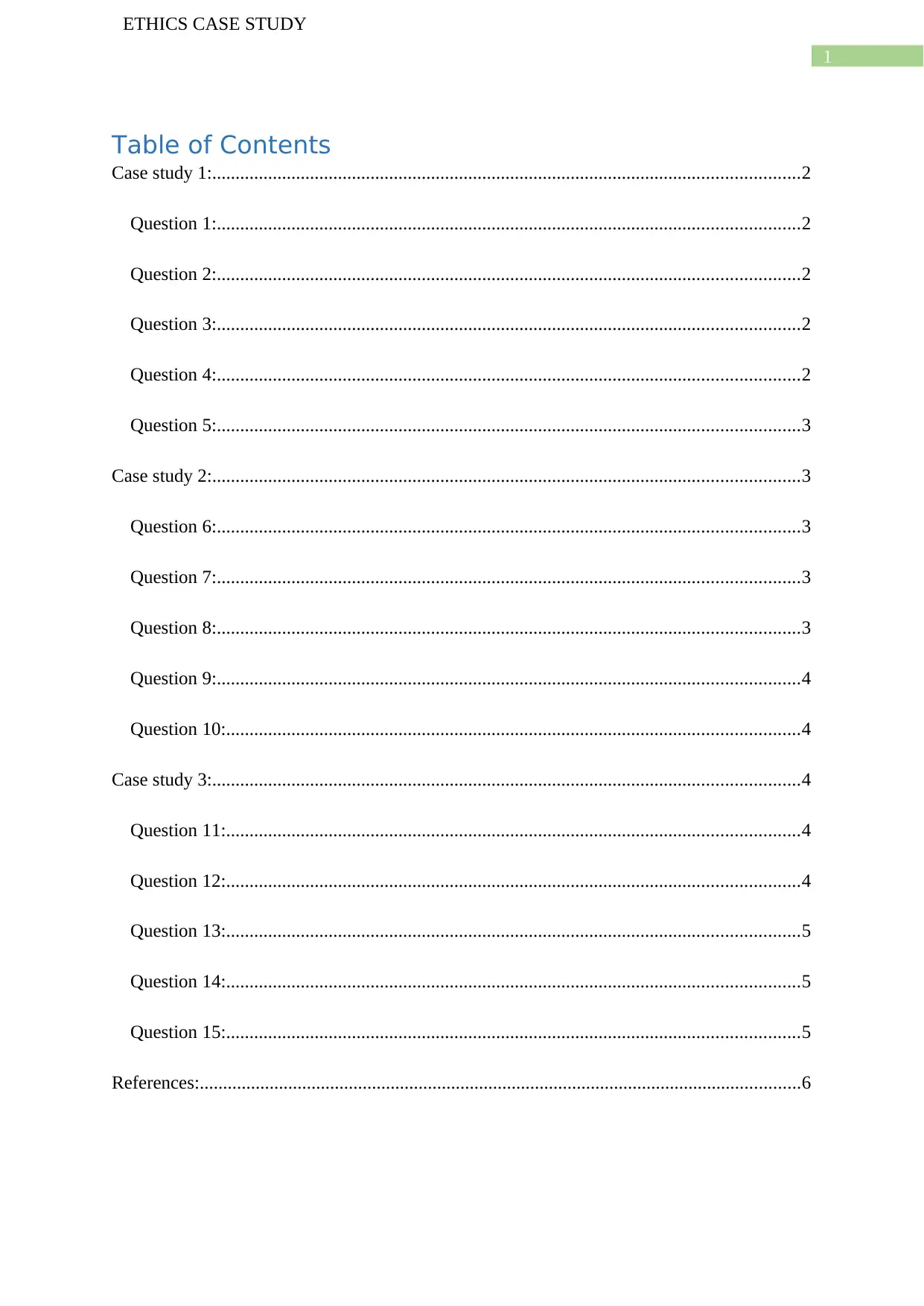
1
ETHICS CASE STUDY
Table of Contents
Case study 1:..............................................................................................................................2
Question 1:.............................................................................................................................2
Question 2:.............................................................................................................................2
Question 3:.............................................................................................................................2
Question 4:.............................................................................................................................2
Question 5:.............................................................................................................................3
Case study 2:..............................................................................................................................3
Question 6:.............................................................................................................................3
Question 7:.............................................................................................................................3
Question 8:.............................................................................................................................3
Question 9:.............................................................................................................................4
Question 10:...........................................................................................................................4
Case study 3:..............................................................................................................................4
Question 11:...........................................................................................................................4
Question 12:...........................................................................................................................4
Question 13:...........................................................................................................................5
Question 14:...........................................................................................................................5
Question 15:...........................................................................................................................5
References:.................................................................................................................................6
ETHICS CASE STUDY
Table of Contents
Case study 1:..............................................................................................................................2
Question 1:.............................................................................................................................2
Question 2:.............................................................................................................................2
Question 3:.............................................................................................................................2
Question 4:.............................................................................................................................2
Question 5:.............................................................................................................................3
Case study 2:..............................................................................................................................3
Question 6:.............................................................................................................................3
Question 7:.............................................................................................................................3
Question 8:.............................................................................................................................3
Question 9:.............................................................................................................................4
Question 10:...........................................................................................................................4
Case study 3:..............................................................................................................................4
Question 11:...........................................................................................................................4
Question 12:...........................................................................................................................4
Question 13:...........................................................................................................................5
Question 14:...........................................................................................................................5
Question 15:...........................................................................................................................5
References:.................................................................................................................................6
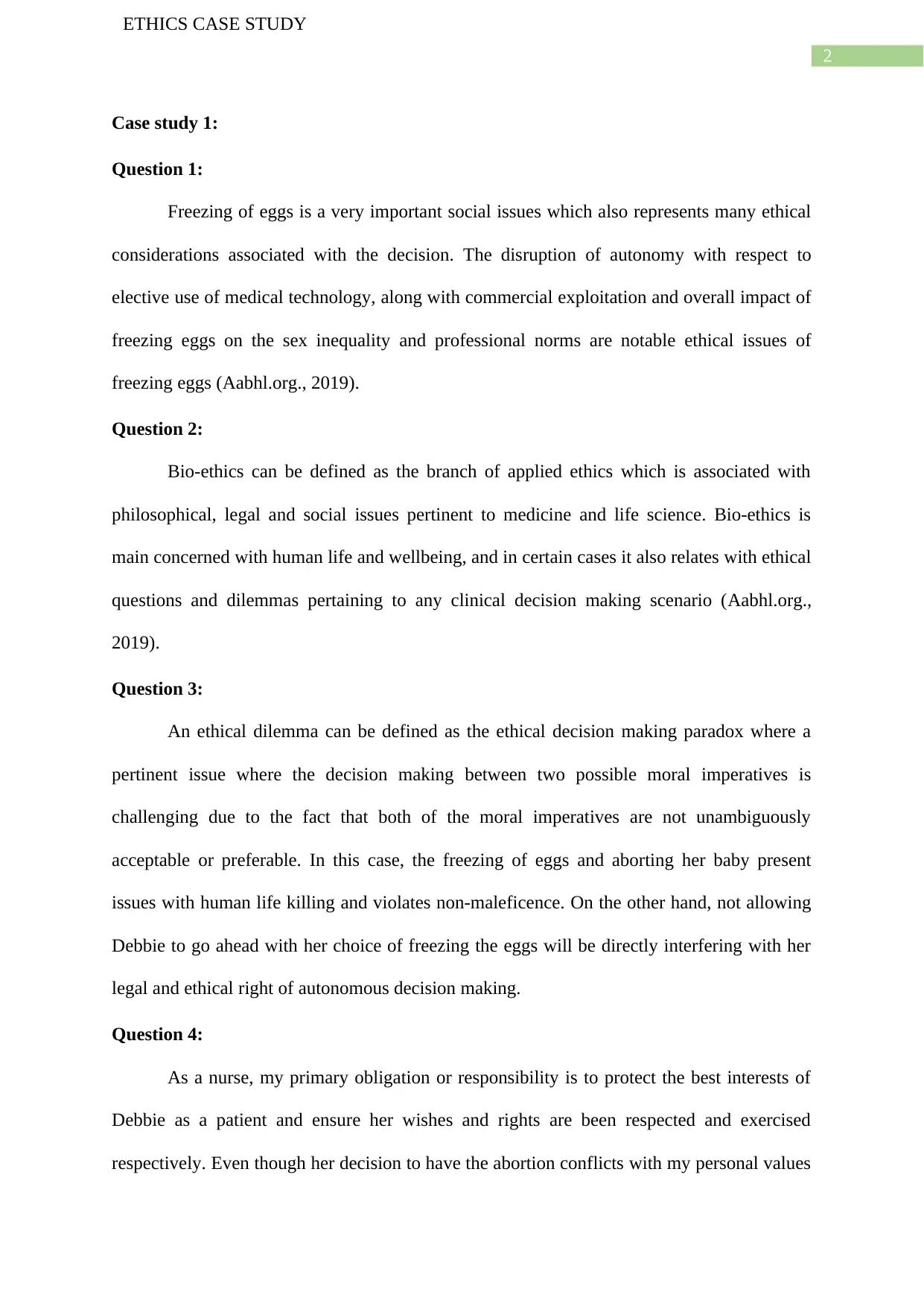
2
ETHICS CASE STUDY
Case study 1:
Question 1:
Freezing of eggs is a very important social issues which also represents many ethical
considerations associated with the decision. The disruption of autonomy with respect to
elective use of medical technology, along with commercial exploitation and overall impact of
freezing eggs on the sex inequality and professional norms are notable ethical issues of
freezing eggs (Aabhl.org., 2019).
Question 2:
Bio-ethics can be defined as the branch of applied ethics which is associated with
philosophical, legal and social issues pertinent to medicine and life science. Bio-ethics is
main concerned with human life and wellbeing, and in certain cases it also relates with ethical
questions and dilemmas pertaining to any clinical decision making scenario (Aabhl.org.,
2019).
Question 3:
An ethical dilemma can be defined as the ethical decision making paradox where a
pertinent issue where the decision making between two possible moral imperatives is
challenging due to the fact that both of the moral imperatives are not unambiguously
acceptable or preferable. In this case, the freezing of eggs and aborting her baby present
issues with human life killing and violates non-maleficence. On the other hand, not allowing
Debbie to go ahead with her choice of freezing the eggs will be directly interfering with her
legal and ethical right of autonomous decision making.
Question 4:
As a nurse, my primary obligation or responsibility is to protect the best interests of
Debbie as a patient and ensure her wishes and rights are been respected and exercised
respectively. Even though her decision to have the abortion conflicts with my personal values
ETHICS CASE STUDY
Case study 1:
Question 1:
Freezing of eggs is a very important social issues which also represents many ethical
considerations associated with the decision. The disruption of autonomy with respect to
elective use of medical technology, along with commercial exploitation and overall impact of
freezing eggs on the sex inequality and professional norms are notable ethical issues of
freezing eggs (Aabhl.org., 2019).
Question 2:
Bio-ethics can be defined as the branch of applied ethics which is associated with
philosophical, legal and social issues pertinent to medicine and life science. Bio-ethics is
main concerned with human life and wellbeing, and in certain cases it also relates with ethical
questions and dilemmas pertaining to any clinical decision making scenario (Aabhl.org.,
2019).
Question 3:
An ethical dilemma can be defined as the ethical decision making paradox where a
pertinent issue where the decision making between two possible moral imperatives is
challenging due to the fact that both of the moral imperatives are not unambiguously
acceptable or preferable. In this case, the freezing of eggs and aborting her baby present
issues with human life killing and violates non-maleficence. On the other hand, not allowing
Debbie to go ahead with her choice of freezing the eggs will be directly interfering with her
legal and ethical right of autonomous decision making.
Question 4:
As a nurse, my primary obligation or responsibility is to protect the best interests of
Debbie as a patient and ensure her wishes and rights are been respected and exercised
respectively. Even though her decision to have the abortion conflicts with my personal values
⊘ This is a preview!⊘
Do you want full access?
Subscribe today to unlock all pages.

Trusted by 1+ million students worldwide
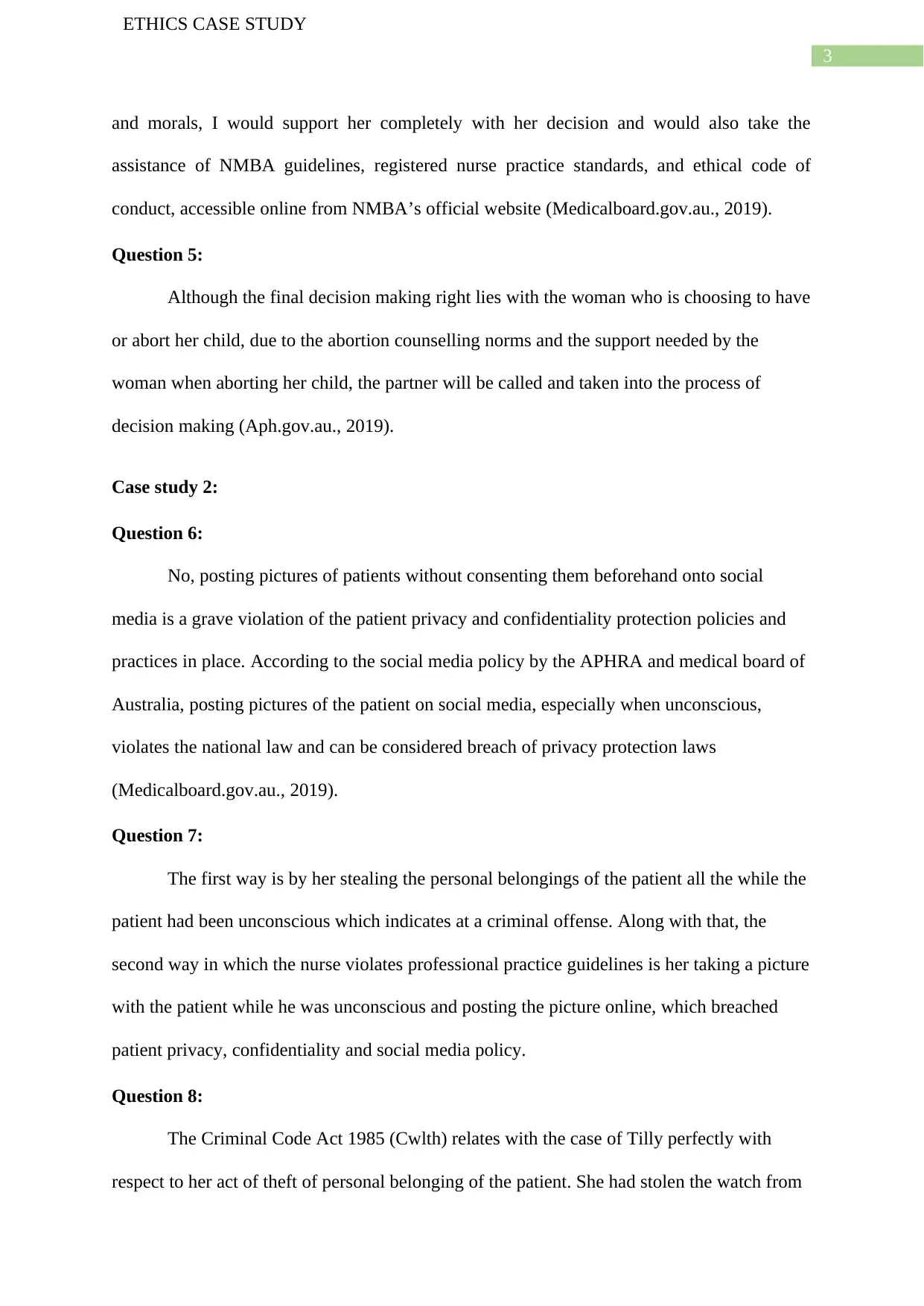
3
ETHICS CASE STUDY
and morals, I would support her completely with her decision and would also take the
assistance of NMBA guidelines, registered nurse practice standards, and ethical code of
conduct, accessible online from NMBA’s official website (Medicalboard.gov.au., 2019).
Question 5:
Although the final decision making right lies with the woman who is choosing to have
or abort her child, due to the abortion counselling norms and the support needed by the
woman when aborting her child, the partner will be called and taken into the process of
decision making (Aph.gov.au., 2019).
Case study 2:
Question 6:
No, posting pictures of patients without consenting them beforehand onto social
media is a grave violation of the patient privacy and confidentiality protection policies and
practices in place. According to the social media policy by the APHRA and medical board of
Australia, posting pictures of the patient on social media, especially when unconscious,
violates the national law and can be considered breach of privacy protection laws
(Medicalboard.gov.au., 2019).
Question 7:
The first way is by her stealing the personal belongings of the patient all the while the
patient had been unconscious which indicates at a criminal offense. Along with that, the
second way in which the nurse violates professional practice guidelines is her taking a picture
with the patient while he was unconscious and posting the picture online, which breached
patient privacy, confidentiality and social media policy.
Question 8:
The Criminal Code Act 1985 (Cwlth) relates with the case of Tilly perfectly with
respect to her act of theft of personal belonging of the patient. She had stolen the watch from
ETHICS CASE STUDY
and morals, I would support her completely with her decision and would also take the
assistance of NMBA guidelines, registered nurse practice standards, and ethical code of
conduct, accessible online from NMBA’s official website (Medicalboard.gov.au., 2019).
Question 5:
Although the final decision making right lies with the woman who is choosing to have
or abort her child, due to the abortion counselling norms and the support needed by the
woman when aborting her child, the partner will be called and taken into the process of
decision making (Aph.gov.au., 2019).
Case study 2:
Question 6:
No, posting pictures of patients without consenting them beforehand onto social
media is a grave violation of the patient privacy and confidentiality protection policies and
practices in place. According to the social media policy by the APHRA and medical board of
Australia, posting pictures of the patient on social media, especially when unconscious,
violates the national law and can be considered breach of privacy protection laws
(Medicalboard.gov.au., 2019).
Question 7:
The first way is by her stealing the personal belongings of the patient all the while the
patient had been unconscious which indicates at a criminal offense. Along with that, the
second way in which the nurse violates professional practice guidelines is her taking a picture
with the patient while he was unconscious and posting the picture online, which breached
patient privacy, confidentiality and social media policy.
Question 8:
The Criminal Code Act 1985 (Cwlth) relates with the case of Tilly perfectly with
respect to her act of theft of personal belonging of the patient. She had stolen the watch from
Paraphrase This Document
Need a fresh take? Get an instant paraphrase of this document with our AI Paraphraser
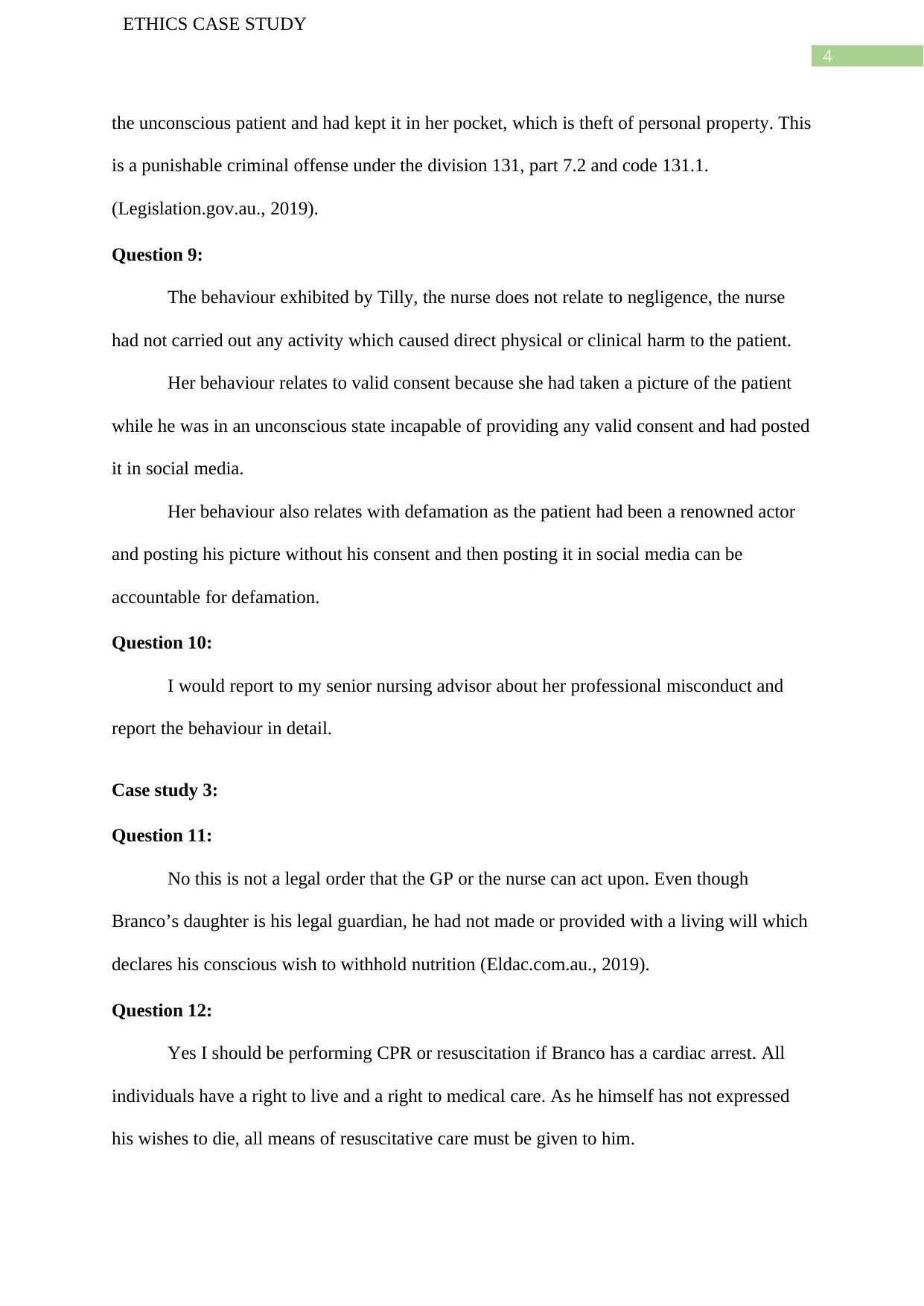
4
ETHICS CASE STUDY
the unconscious patient and had kept it in her pocket, which is theft of personal property. This
is a punishable criminal offense under the division 131, part 7.2 and code 131.1.
(Legislation.gov.au., 2019).
Question 9:
The behaviour exhibited by Tilly, the nurse does not relate to negligence, the nurse
had not carried out any activity which caused direct physical or clinical harm to the patient.
Her behaviour relates to valid consent because she had taken a picture of the patient
while he was in an unconscious state incapable of providing any valid consent and had posted
it in social media.
Her behaviour also relates with defamation as the patient had been a renowned actor
and posting his picture without his consent and then posting it in social media can be
accountable for defamation.
Question 10:
I would report to my senior nursing advisor about her professional misconduct and
report the behaviour in detail.
Case study 3:
Question 11:
No this is not a legal order that the GP or the nurse can act upon. Even though
Branco’s daughter is his legal guardian, he had not made or provided with a living will which
declares his conscious wish to withhold nutrition (Eldac.com.au., 2019).
Question 12:
Yes I should be performing CPR or resuscitation if Branco has a cardiac arrest. All
individuals have a right to live and a right to medical care. As he himself has not expressed
his wishes to die, all means of resuscitative care must be given to him.
ETHICS CASE STUDY
the unconscious patient and had kept it in her pocket, which is theft of personal property. This
is a punishable criminal offense under the division 131, part 7.2 and code 131.1.
(Legislation.gov.au., 2019).
Question 9:
The behaviour exhibited by Tilly, the nurse does not relate to negligence, the nurse
had not carried out any activity which caused direct physical or clinical harm to the patient.
Her behaviour relates to valid consent because she had taken a picture of the patient
while he was in an unconscious state incapable of providing any valid consent and had posted
it in social media.
Her behaviour also relates with defamation as the patient had been a renowned actor
and posting his picture without his consent and then posting it in social media can be
accountable for defamation.
Question 10:
I would report to my senior nursing advisor about her professional misconduct and
report the behaviour in detail.
Case study 3:
Question 11:
No this is not a legal order that the GP or the nurse can act upon. Even though
Branco’s daughter is his legal guardian, he had not made or provided with a living will which
declares his conscious wish to withhold nutrition (Eldac.com.au., 2019).
Question 12:
Yes I should be performing CPR or resuscitation if Branco has a cardiac arrest. All
individuals have a right to live and a right to medical care. As he himself has not expressed
his wishes to die, all means of resuscitative care must be given to him.
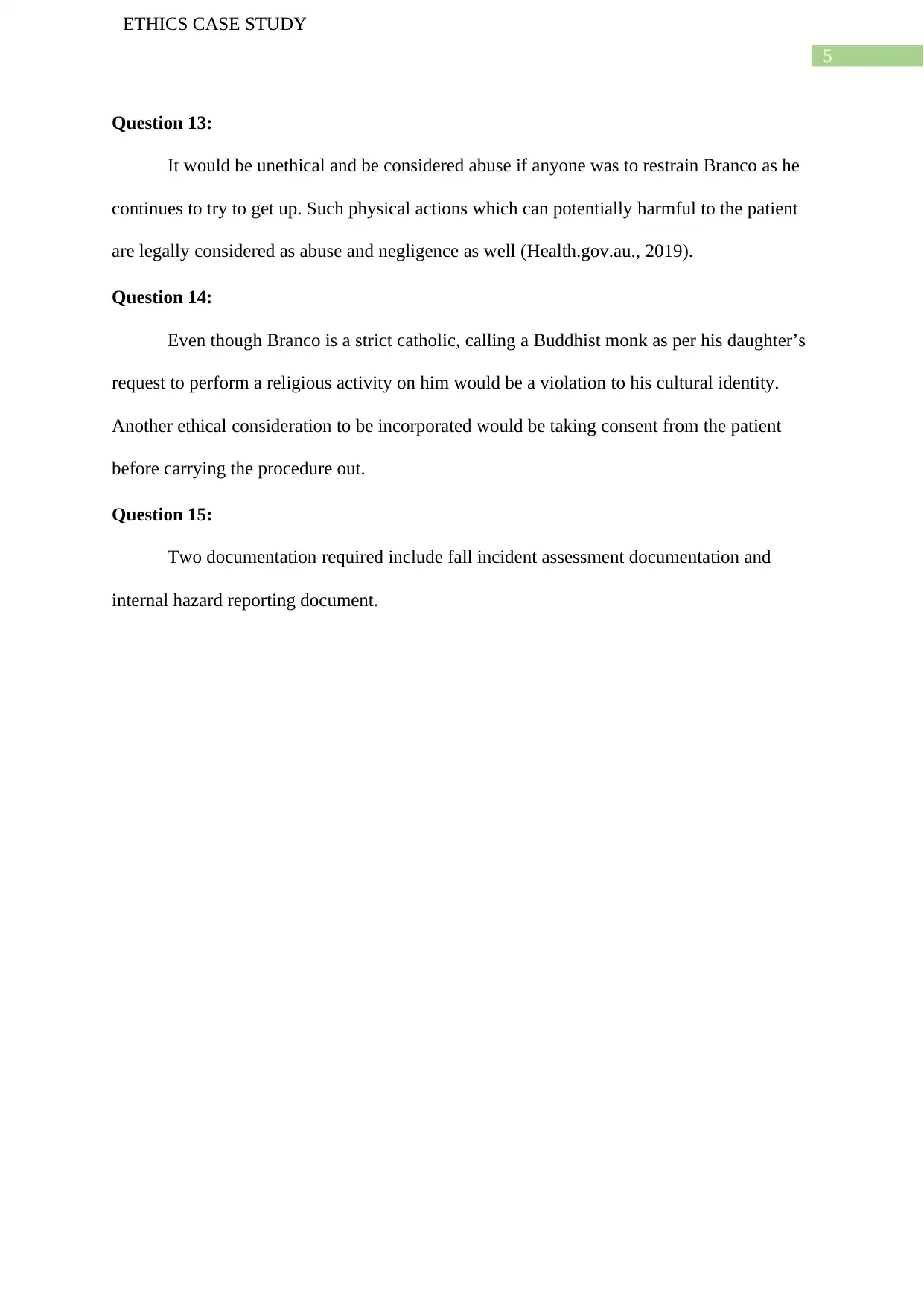
5
ETHICS CASE STUDY
Question 13:
It would be unethical and be considered abuse if anyone was to restrain Branco as he
continues to try to get up. Such physical actions which can potentially harmful to the patient
are legally considered as abuse and negligence as well (Health.gov.au., 2019).
Question 14:
Even though Branco is a strict catholic, calling a Buddhist monk as per his daughter’s
request to perform a religious activity on him would be a violation to his cultural identity.
Another ethical consideration to be incorporated would be taking consent from the patient
before carrying the procedure out.
Question 15:
Two documentation required include fall incident assessment documentation and
internal hazard reporting document.
ETHICS CASE STUDY
Question 13:
It would be unethical and be considered abuse if anyone was to restrain Branco as he
continues to try to get up. Such physical actions which can potentially harmful to the patient
are legally considered as abuse and negligence as well (Health.gov.au., 2019).
Question 14:
Even though Branco is a strict catholic, calling a Buddhist monk as per his daughter’s
request to perform a religious activity on him would be a violation to his cultural identity.
Another ethical consideration to be incorporated would be taking consent from the patient
before carrying the procedure out.
Question 15:
Two documentation required include fall incident assessment documentation and
internal hazard reporting document.
⊘ This is a preview!⊘
Do you want full access?
Subscribe today to unlock all pages.

Trusted by 1+ million students worldwide
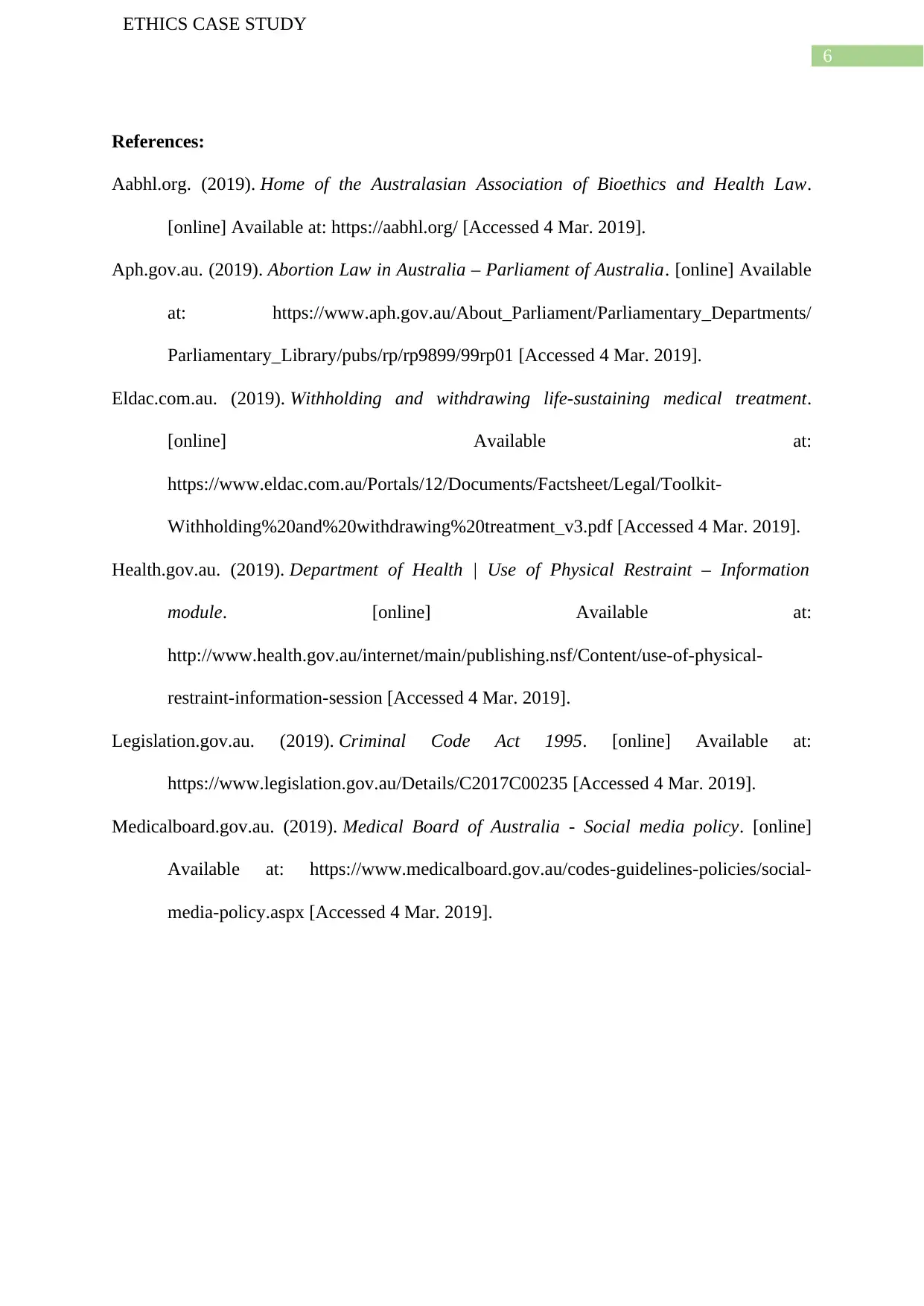
6
ETHICS CASE STUDY
References:
Aabhl.org. (2019). Home of the Australasian Association of Bioethics and Health Law.
[online] Available at: https://aabhl.org/ [Accessed 4 Mar. 2019].
Aph.gov.au. (2019). Abortion Law in Australia – Parliament of Australia. [online] Available
at: https://www.aph.gov.au/About_Parliament/Parliamentary_Departments/
Parliamentary_Library/pubs/rp/rp9899/99rp01 [Accessed 4 Mar. 2019].
Eldac.com.au. (2019). Withholding and withdrawing life-sustaining medical treatment.
[online] Available at:
https://www.eldac.com.au/Portals/12/Documents/Factsheet/Legal/Toolkit-
Withholding%20and%20withdrawing%20treatment_v3.pdf [Accessed 4 Mar. 2019].
Health.gov.au. (2019). Department of Health | Use of Physical Restraint – Information
module. [online] Available at:
http://www.health.gov.au/internet/main/publishing.nsf/Content/use-of-physical-
restraint-information-session [Accessed 4 Mar. 2019].
Legislation.gov.au. (2019). Criminal Code Act 1995. [online] Available at:
https://www.legislation.gov.au/Details/C2017C00235 [Accessed 4 Mar. 2019].
Medicalboard.gov.au. (2019). Medical Board of Australia - Social media policy. [online]
Available at: https://www.medicalboard.gov.au/codes-guidelines-policies/social-
media-policy.aspx [Accessed 4 Mar. 2019].
ETHICS CASE STUDY
References:
Aabhl.org. (2019). Home of the Australasian Association of Bioethics and Health Law.
[online] Available at: https://aabhl.org/ [Accessed 4 Mar. 2019].
Aph.gov.au. (2019). Abortion Law in Australia – Parliament of Australia. [online] Available
at: https://www.aph.gov.au/About_Parliament/Parliamentary_Departments/
Parliamentary_Library/pubs/rp/rp9899/99rp01 [Accessed 4 Mar. 2019].
Eldac.com.au. (2019). Withholding and withdrawing life-sustaining medical treatment.
[online] Available at:
https://www.eldac.com.au/Portals/12/Documents/Factsheet/Legal/Toolkit-
Withholding%20and%20withdrawing%20treatment_v3.pdf [Accessed 4 Mar. 2019].
Health.gov.au. (2019). Department of Health | Use of Physical Restraint – Information
module. [online] Available at:
http://www.health.gov.au/internet/main/publishing.nsf/Content/use-of-physical-
restraint-information-session [Accessed 4 Mar. 2019].
Legislation.gov.au. (2019). Criminal Code Act 1995. [online] Available at:
https://www.legislation.gov.au/Details/C2017C00235 [Accessed 4 Mar. 2019].
Medicalboard.gov.au. (2019). Medical Board of Australia - Social media policy. [online]
Available at: https://www.medicalboard.gov.au/codes-guidelines-policies/social-
media-policy.aspx [Accessed 4 Mar. 2019].
1 out of 7
Related Documents
Your All-in-One AI-Powered Toolkit for Academic Success.
+13062052269
info@desklib.com
Available 24*7 on WhatsApp / Email
![[object Object]](/_next/static/media/star-bottom.7253800d.svg)
Unlock your academic potential
Copyright © 2020–2025 A2Z Services. All Rights Reserved. Developed and managed by ZUCOL.





